In the bustling theater of enterprise operations, certain roles are always in the spotlight: innovation, sales, customer experience. But behind the scenes, ensuring the entire show runs smoothly, is an often unsung hero: logistics and transportation.
For global manufacturers orchestrating complex supply chains, multi-brand consumer goods companies juggling vast inventories, or diversified conglomerates with operations spanning continents, the movement of goods is not merely a task, it's the very heartbeat of their commercial existence.
However, for too many, this hero is hobbled by outdated tools. Imagine trying to conduct a global orchestra with a broken baton and sheet music scribbled on napkins. This is the reality for enterprises still navigating their vast transport networks with legacy ERP modules, isolated spreadsheets, and a patchwork of regional solutions.
The result? A symphony of discord: unforeseen delays, ballooning costs, a frustrating lack of real-time insights, and an alarming inability to adapt to the world's rapid rhythm. Your business cannot move forward if its fundamental movement mechanism is in the past. It's time to empower this unsung hero with the technology it deserves.
We will unveil how a modern Transportation Management System (TMS) can equip your logistics operations with unparalleled precision, visibility, and agility, turning them from a hidden struggle into your most powerful strategic performer.
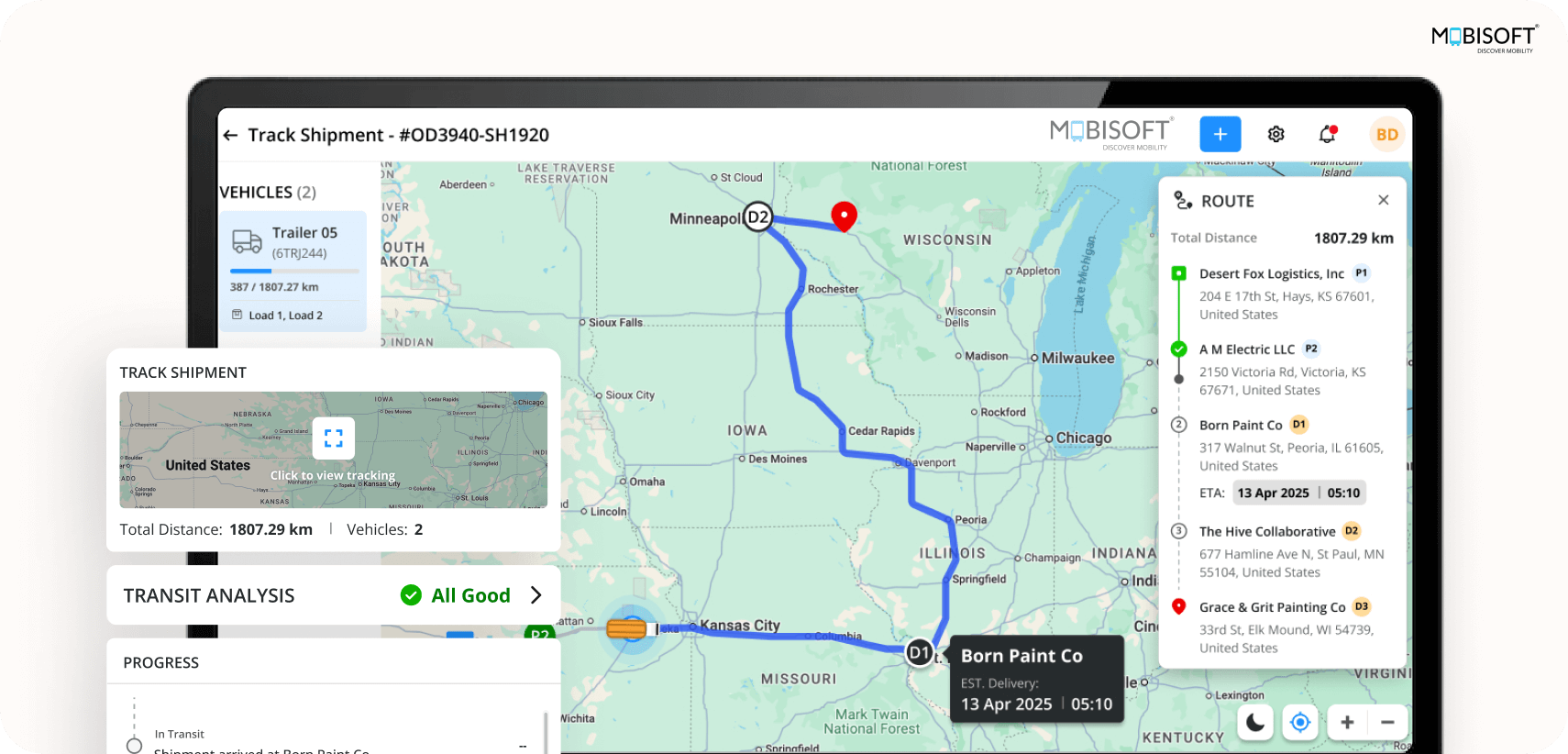
Why Legacy Systems Fall Short
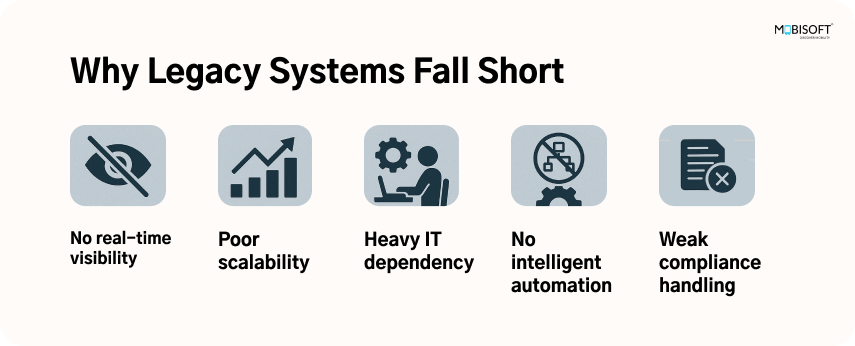
Many enterprises still use outdated ERP modules or spreadsheets to manage transportation. These tools struggle with growing logistics needs and complex business structures. As supply chains evolve, legacy systems become a bottleneck instead of a solution.
Here’s what makes legacy systems ineffective:
- No Real-Time Visibility: You can’t track shipments live. Teams get updates only after issues occur, leading to poor service and missed delivery timelines. Delays in information sharing can escalate into penalties, customer complaints, and broken service-level agreements.
To bridge this gap, integrating a robust Delivery Management Software Solution can offer real-time tracking, route optimization, and improved customer communication, addressing the visibility challenges posed by legacy systems. - Poor Scalability: Each region or business unit often uses different tools. That creates data silos and inconsistent reporting. As a result, decision-makers lack a unified view of transportation activities and struggle to implement centralized strategies.
- Heavy IT Dependency: You need IT teams or vendors for simple updates like editing workflows or adding new rate cards. This slows down your response to change. Operational leaders are left waiting for technical support rather than taking quick action.
- No Intelligent Automation: Manual routing, costing, and exception handling take too much time. Errors increase, and productivity drops. Human dependency on repetitive tasks makes it difficult to scale during demand spikes or manage seasonal volumes.
- Weak Compliance Handling: You can't track document versions or enforce policies uniformly. It becomes difficult to meet global audit and compliance requirements. Gaps in documentation and reporting leave enterprises vulnerable to penalties and legal risks.
In essence, legacy systems were not built for today’s fast-changing logistics environment. As enterprise transportation grows in complexity, these old tools fall short in agility, accuracy, and control.

A New-Age TMS for Enterprise-Grade Needs
Enterprises need more than just a digital interface for transportation. They require a powerful, adaptable, and intelligent system that can grow with their scale and complexity. A modern TMS is not just a logistics tool; it’s a strategic technology layer that ties operations together, improves coordination, and delivers actionable insights.
Let’s dive into what makes a next-generation TMS essential for enterprise-level logistics:
Scalable Across Geographies & Business Units
A modern TMS must scale without friction. Enterprises often operate across countries, regions, or business divisions. Managing logistics for each with siloed systems creates fragmentation and inefficiencies.
A scalable TMS allows you to operate on a single, unified platform, regardless of the number of plants, warehouses, or distribution points involved. You can create region-specific rules, assign division-level roles, and track product category-specific KPIs without toggling between different systems. This simplifies governance and reduces duplication of effort.
It also supports localization in multiple languages, currencies, and regulatory frameworks, making it easier to run global supply chains with local flexibility.
Customizable Without Developer Dependency
In large organizations, requirements evolve frequently. You may need to add approval steps, change rules based on product categories, or alter workflows due to new compliance mandates.
With a next-gen TMS, you don’t need to go back to your IT team or third-party developers every time you want a small change. You can drag, drop, and configure workflows, rules, and forms without touching code. That means operations teams can act faster and stay agile.
You can also create role-based user journeys from plant managers to finance heads, ensuring everyone sees and manages only what’s relevant to them.
ERP & WMS Integrated
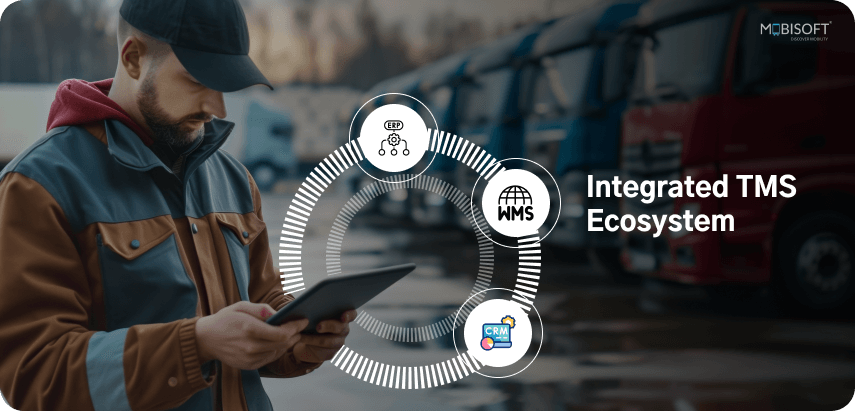
Transportation doesn’t operate in a vacuum. It sits between order management, inventory control, and finance. A powerful TMS must integrate seamlessly with your ERP, WMS, CRM, or third-party portals.
This ensures that orders flow automatically into dispatch planning, stock levels stay in sync with shipment status, and freight invoices align with actual movement data. You eliminate data duplication, reduce reconciliation time, and improve accuracy.
Support for leading platforms like SAP, Oracle, Microsoft Dynamics, and custom ERP systems ensures flexibility and future-proofing. With APIs and plug-and-play connectors, enterprises get faster deployment and less disruption.
Secure, Role-Based Access
Large organizations handle sensitive data, customer details, financial documents, route information, and vendor contracts. A TMS must meet enterprise-grade security and compliance standards to be viable.
Look for platforms that are compliant with SOC 2, ISO 27001, and GDPR. These standards ensure data integrity, security controls, and privacy management. Role-based access ensures that only the right people view or act on specific data. You can track all activity with detailed audit logs, which helps during internal audits and regulatory checks.
You also have deployment flexibility. Enterprises that require private cloud or on-premise hosting can configure infrastructure according to internal IT and compliance policies. This makes it easier to align with data sovereignty or industry-specific mandates.
Analytics-Driven Decision Making
Without analytics, data is just noise. Enterprises need real-time insights to make informed decisions and anticipate problems before they occur.
A modern TMS offers a real-time dashboard for end-to-end shipment visibility. You can monitor delays, track on-time delivery percentages, and measure SLA adherence across carriers. Use lane-wise performance reports to renegotiate freight contracts or identify high-cost bottlenecks that need attention.
It doesn’t stop there. Predictive insights can flag recurring exceptions like late pickups or missing documents so you can address systemic issues proactively. Cost optimization reports help you compare actuals vs. estimates and identify opportunities for freight savings.
The analytics are not just operational; they support strategic decisions. From capacity planning to vendor scorecards, these tools help you plan better, scale smarter, and spend more efficiently.
Enterprise Outcomes
A modern, scalable TMS creates a positive ripple effect across the entire business. From cost savings to better control, the outcomes are clear and measurable.
Let’s break down the key benefits:
Save Up to 30% in Freight and Operational Costs
Reducing logistics costs is a top priority for every enterprise. A modern TMS helps you get there.
It automates repetitive tasks, cuts down manual errors, and selects the most cost-effective carrier every time. Smarter route planning lowers fuel expenses. Automated billing eliminates costly mistakes.
You also avoid penalties from missed SLAs because deliveries run more smoothly. Dynamic load planning ensures trucks don’t run half full. Shipments get consolidated, which means fewer vehicles, better fuel use, and lower overall expenses.
Over time, these efficiencies lead to significant savings. You spend less, waste less, and improve how every logistics rupee is used.
Real-Time Visibility Across All Shipments
Large enterprises manage shipments across geographies. Without real-time visibility, teams end up working in silos. Issues get addressed after they happen instead of before.
With a new-age TMS, you gain end-to-end visibility over every shipment. You can track goods in real-time from dispatch to delivery across regions and transport modes.
Live GPS updates, automated alerts, and centralized dashboards keep your logistics, customer service, and vendor teams aligned. If a delay happens, you immediately know what went wrong, where it happened, and how to fix it.
This level of control leads to faster decisions and fewer disruptions. It also builds greater trust both within your teams and with external partners and customers.
Better SLA Compliance and On-Time Delivery
Customers today expect accurate delivery timelines, no matter the complexity behind the scenes. Enterprises that can consistently meet service-level agreements (SLAs) gain a competitive edge.
A TMS helps enforce delivery schedules with route planning, automated reminders, and real-time escalation. It tracks performance across carriers and lanes so you know who delivers on time and who doesn’t.
You can use this data to improve vendor selection, hold partners accountable, and drive higher delivery reliability across all routes.
Faster Freight Settlement and Invoice Reconciliation
Manual reconciliation is time-consuming and error-prone. Freight invoices often include accessorial charges, multiple rate slabs, or mismatched delivery dates. Sorting through this manually slows down accounts payable and strains vendor relationships.
With TMS automation, invoice validation becomes quicker and more accurate. The system matches invoices with trip data, rate cards, and proof of delivery. Discrepancies are flagged instantly. This speeds up payment cycles, improves financial accuracy, and strengthens trust with logistics partners.
Finance teams get cleaner data, and transport teams save hours of manual effort every week.
Improved Collaboration with 3PLs and Carriers
Smooth coordination with third-party logistics providers and carriers is critical for large enterprises. A modern TMS offers a shared platform where external partners can access dispatch plans, update trip statuses, and upload documents in real-time.
Instead of relying on calls or emails, everyone works on the same system. Communication becomes faster. Documentation is digital and standardized. This improves accountability, reduces errors, and boosts efficiency.
Over time, it also builds stronger relationships with your logistics network based on data, performance, and transparency.
For instance, our Streamlining Supply Chain Management case study demonstrates how our solutions have transformed logistics operations for enterprises, leading to significant improvements in efficiency and cost-effectiveness.
Conclusion
For enterprises, logistics is no longer just about moving goods; it’s about moving fast, staying agile, and delivering consistently. In today’s competitive landscape, legacy tools and manual processes simply can’t keep up. Delays, data gaps, compliance issues, and rising costs are symptoms of systems no longer built for scale.
A modern Transportation Management System (TMS) offers a future-ready foundation. It simplifies complexity, connects workflows, and drives automation across the logistics value chain. From real-time visibility to smart freight planning, and from seamless integrations to robust data security, it brings everything under one digital roof.
More importantly, it enables enterprises to operate with confidence. Leaders can scale logistics without scaling inefficiencies. Teams can make faster, data-backed decisions. Partners can collaborate better. Customers receive on-time deliveries with fewer exceptions.
A modern TMS goes beyond transportation; it helps your entire business grow in a smarter, more sustainable way.
Want to see how it works for you? Schedule a personalized demo and start building a stronger logistics strategy today.
In short, a modern TMS doesn’t just optimize transportation, it empowers the entire business to grow sustainably and competitively.
Ready to unlock the full potential of your logistics operations? Book a customized demo now and take the first step toward smarter, scalable enterprise logistics.
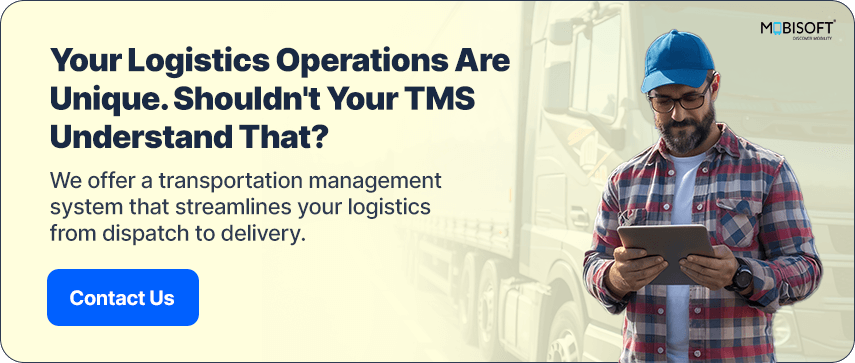

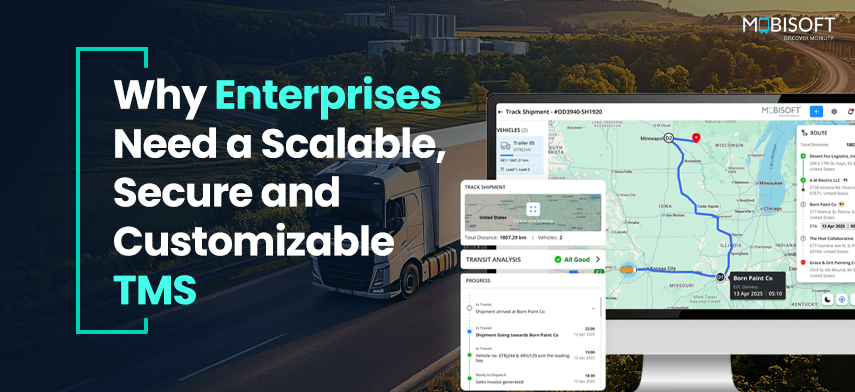


 May 26, 2025
May 26, 2025


